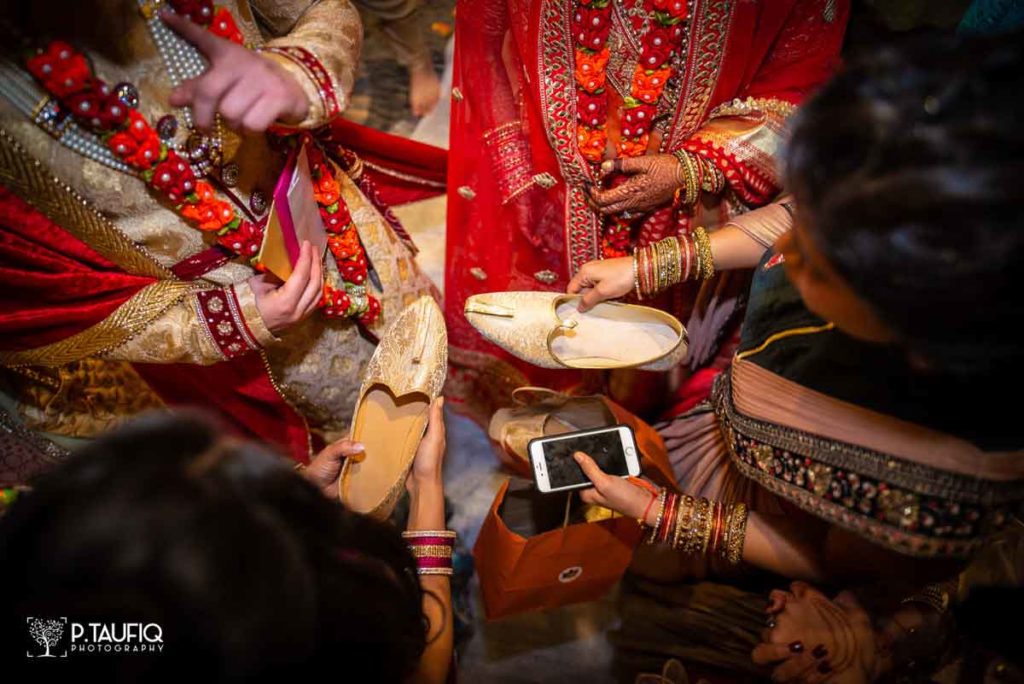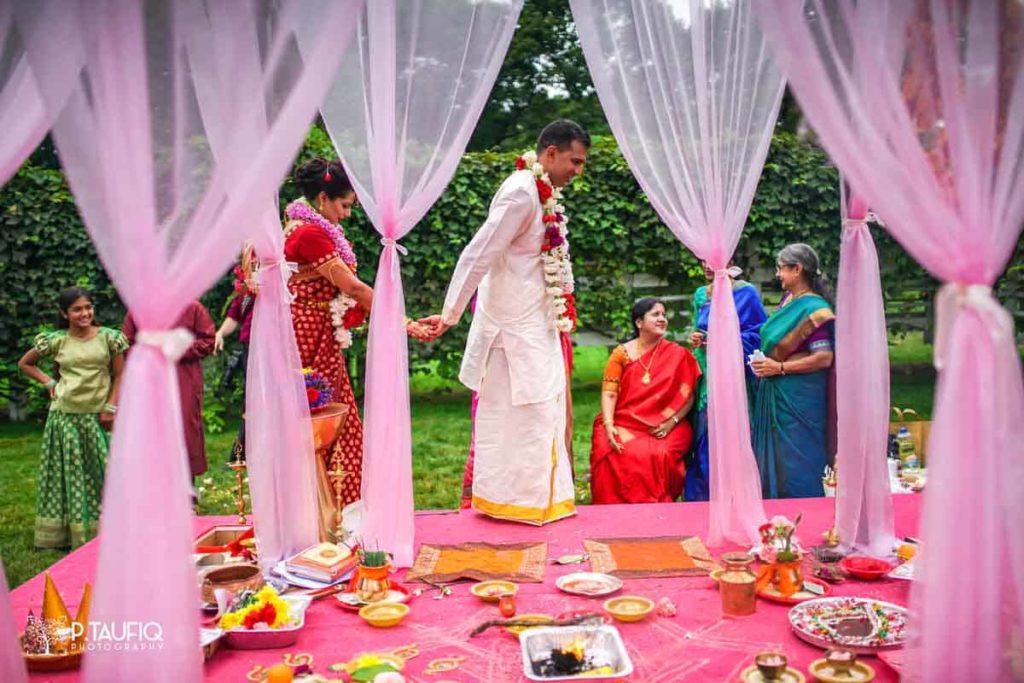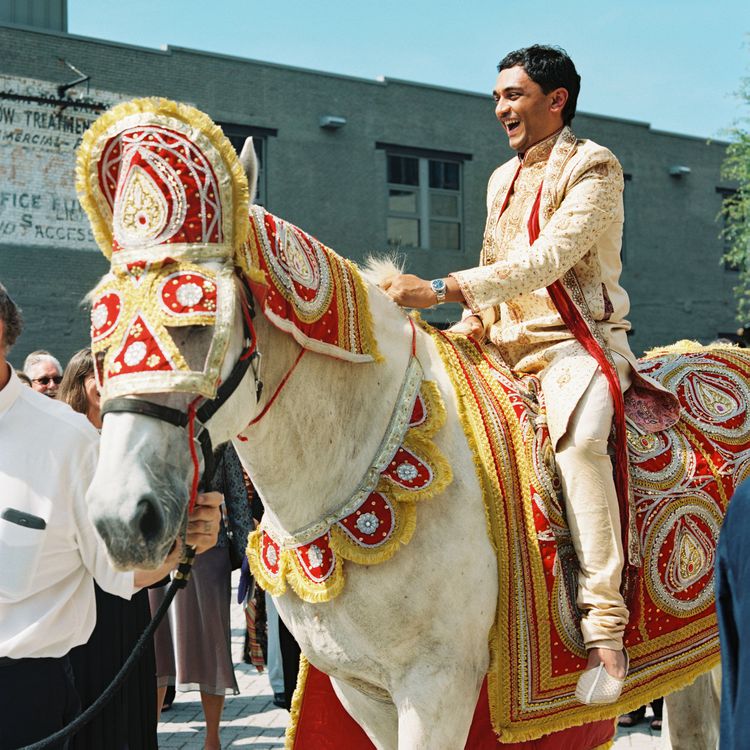India is a melting pot of cultural traditions with exotic rituals, vibrant colours and multi-day ceremonies transforming the average wedding into a carnival-like extravaganza!
Table of Contents
While the physical, spiritual, and emotional union of two individuals is at the heart of a Hindu wedding ceremony, it’s also about the unification of two families religiously and through celebration.
Check out some of our favourite Indian wedding traditions that prove that our Bollywood-loving friends know how to party.
1. The Shoe Lovers
If you are having a traditional Indian wedding, then you might want to tell the groom not to spend too much on his shoes.
On the day of his wedding, the customary Hindu Groom wears Joota, embroidered Indian footwear. These shoes are used in a lighthearted rite following the Baraat ceremony. The Joota Chupai, is a centuries-old Indian bridal rite that includes both the bride and groom’s families playing roles in hiding and seeking the shoes. Essentially, the Bride’s side takes the shoes whilst the groom’s side tries to find them.
Their goal is to make money after the wedding ceremony when the Groom wants to exit the venue and requires his shoes. When the Groom’s relatives and friends are unable to locate the joota, the Groom is obliged to negotiate. The females give the joota in exchange for a large sum of money, putting a stop to the rite.
The Joota Chupai game is supposed to demonstrate both sides of the family’s acceptance and open hearts, as well as their willingness and readiness to spend a lifetime of laughing and pleasure together.

2. The Spicy Facial
Pithi is an Indian pre-wedding custom which involves the bride rubbing a paste made from turmeric, chickpea flour and rosewater all over her face and body. This is said to brighten up your skin, giving you the ultimate wedding day glow. This is known as the Haldi ritual in Hindu weddings, and is applied on the pair for beauty and good luck.
There are numerous parallels between the goal and the practise. It’s a pre-wedding custom in which a turmeric paste is applied on the couple. The wedding ceremony kicks off the festivities and represents wealth, peace, purity, good luck, and a pleasant start to wedded life.
3. Stepping into Married Life
Saptapadi is the most intimate part of an Indian ceremony. In many Indian wedding rituals, a ceremonial fire is used. Saptapadi involves the couple walking seven steps around the holy fire. As the couple takes each step, a sacred vow is made. The steps include values on respect, achieving mental, physical and spiritual balance, prosperity, happiness, fertility, faithfulness and achieving Moksha.

4. Horsing Around
If you’ve ever dreamt of a knight in shining armour riding his gallant steed to sweep you off your feet, then this Indian custom is for you. Known as Baraat, this is when the groom arrives at his wedding on horseback accompanied by a huge party of family and friends dancing and chanting to traditional music. The meeting of the bride and groom’s families at the entrance of the ceremony represent acceptance.

5. Hearts on Fire
Manual Phere is a Hindu custom that involves the happy couple circling a sacred fire seven times. As they circle the fire, the couple must think about the four objectives in life. These include; Dharma (duty to family and god); Karma (Sacred energy); Artha (Prosperity) and Moksha (Liberation). The bride symbolises divinity and leads the groom in the first three rounds, while the groom leads the last four (super romantic!). Here comes the fun bit … after the sacred rounds, there is a race to see who can sit first and the winner is said to rule the household!
6. Playing Game
Aeki Beki is a custom practiced by the Gujarati people. It’s a fun and joyous game for the couple who aren’t afraid to get their hands dirty! In this tradition, a tray of water is mixed with milk and snider (vermillion) and then filled with coins and a ring. The aim is to find the ring four out of seven times to be the winner, and you guessed it! The winner will rule the household and receives token money and gifts from the family.

FAQs about Indian weddings
What to expect at an Indian wedding?
Typically, an Indian wedding lasts about three days. The first day is an intimate ceremony between the couple and their close relatives. The second day is where the Sangeet takes place in the evening. This is generally open to all guests. The third day is the main ceremony. You could be invited to any or all three.
How long is an Indian wedding ceremony?
The ceremony that takes place on the third day usually is between one and a half and two hours! followed by a reception.
What does an Indian bride wear?
A wedding lehenga is a traditional Indian dress worn during weddings. Brides do not wear white in traditional Indian weddings because it is a colour of mourning (unlike westerners). Instead, they choose a vibrant sari that expresses their ethnicity.
What does an Indian groom wear?
A long jacket, known as a Sherwani, is worn by the groom over fitting pants, known as Churidas. They are usually worn in a hue that complements the bride. Gold or white are popular choices. His Mojari loafers, which are usually made of leather, and are removed before entering the mandap.